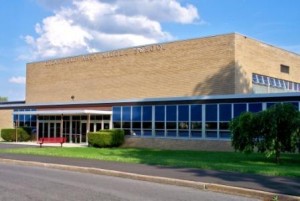
CLEARFIELD – The Clearfield Area School District Board of Directors heard the results and subsequent recommendations that stemmed from its comprehensive roofing analysis for the Girard-Goshen Elementary School at Monday night’s regular meeting.
In October, the board approved the temporary closure of the 9-year-old school because of structural issues related to its roofing system. Just weeks later, approximately 70 students and all of the faculty and staff resumed their academic year at the Clearfield Elementary School.
Nevin E. Taylor of the civil engineering firm C.S. Davidson of York presented what he referred to as “major recommendations” to resolve the current roofing problems. According to him, support should be provided to the ridges and valleys of the roof; bridges need be installed in the current roofing system; and the top and bottom chords of the trusses should be strengthened.
In addition, he said that approximately 5,000 square feet of the roof’s decking should be removed and refurbished in drift areas, and a steel beam should be installed to eliminate the stress placed on some trusses. If the district only replaced the problem areas, he said the roofing may have a “patchwork” look to it afterward. He said it’s up to the district to decide whether it would be partially or entirely replaced.
Taylor said that it would cost the district approximately $925,000 to proceed with the recommended roofing repairs at Girard-Goshen. Rick Bunning, director of buildings and grounds, reported that he’d been in touch with J. Greer Hayden, the district’s architect of HHSDR Architects/Engineers, who told him a shingled roof would be an additional $400,000, while a metal roofing system would be $500,000.
C.S. Davidson became involved at the request of Bunning in September of last year and performed an initial assessment. “It was a rainy day. We could see issues with water leaking throughout and the localized damage to the trusses,” Taylor said.
“The deck flexed under us while we walked on the roof, and so there was a reason for concern. We recommended an inspection of the roof. But in late November, the school district decided to close the building. We didn’t recommend (that option) just that it monitor the snow load.”
In addition, the board hired C.S. Davidson to further investigate the severity of the roofing problems and to determine methods by which they could be resolved.
Taylor said Girard-Goshen was originally constructed in 2002 and measures 16,700 square feet. The school, a single-story masonry bearing structure, stands about 36 feet with wings of 19 feet.
During his presentation, Taylor said the building’s roofing issues were the result of improper design and construction while displaying diagrams and photographs to illustrate examples of the same.
Taylor said the school’s roof framing primarily consists of sloped top chord, level bottom chord with a structure of lighter-gauge metal trusses at typical four feet spacing. The trusses’ webs and chords appear to be constructed of “unistrut-like” sections that have been riveted together.
He said the roof’s issues originated in areas, where its deck is unsupported and leaves the gypsum wallboard exposed and spanning over the gap. “There is a lack of continuous deck support along the diagonally-oriented ridges and valleys, and it results in the edges of the diagonally mitered roof deck being unsupported between trusses.”
According to him, there’s evidence of water leaks throughout the school building, while you can hear the sounds of dripping water in the ceiling cavity. He said there are staining spots on the CMU walls and numerous spots on the undersides of the suspended ceilings.
Several of the exposed trusses in the multi-purpose storage and boiler room have MEP items suspended from their bottom chords, with almost all of the unistrut frames between consecutive trusses. Some are clamped or rest on the bottom chords, while others are connected by bolts that penetrate these chords, he said.
The observed damage to the trusses’ web members here show minor pinching or are bent a half-inch out of a straight line. However, these deformities could still be a reason for concern, as these web members appear to be compression elements and more susceptible to buckling under axial load conditions from the roof.
Taylor said that code requires them to evaluate the capacity of the roof’s truss design for holding dead loads, live loads, snow loads and wind loads. Dead and snow loads dominated the focus of the analysis and raised a “key point” in the study,” he said.
Upon review and calculations, he said the trusses adjacent to the high roof were not designed for additional snow drifts. He said the 30 per square foot live load, which was applied to the top chord, is well below the 50 per square foot that was in the specifications, and a higher specified live load should have been used for the roof’s trusses.
Also, he said that the 15 per square foot dead load applied to the top chords appear to be adequate. In contrast, the 10 per square foot dead load applied to the bottom chords may not be for the combination of the suspended ceilings and MEP elements.
“The designer didn’t account for drifting snow coming off the high roof and piling up against the vertical wall. There’s a heavy localized load on the truss there,” Taylor said.
Glass said the district was continuing its investigation into the roofing problems at the school. “We’re reserving our right to pursue litigation,” he said.
The district scheduled its next feasibility study meeting for 6 p.m. Monday, March 7 at the Clearfield Middle School auditorium.